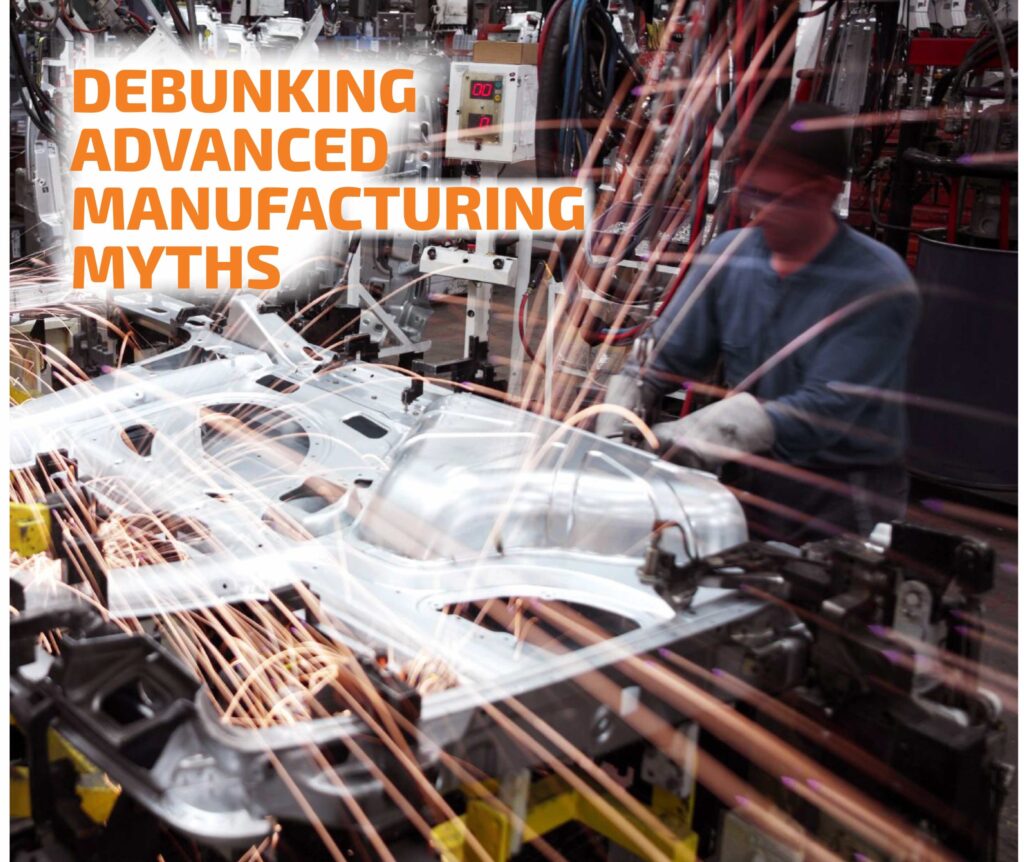Debunking Common Misconceptions About Advanced Manufacturing Careers
Disparaging myths have circulated about American manufacturing for decades. Parents have misconceptions of manufacturing jobs and have discouraged their children from pursuing careers in manufacturing because they think factories are dirty and dangerous, or lacking a solid wage and career opportunities.
The reality is that manufacturing is an advanced, high-value industry that represents innovation and technology. Working in manufacturing offers today’s workforce great compensation and benefits, a robust market of available jobs, challenging and cutting-edge work, and safe working conditions.

Dispelling the Myths:
- Many of today’s manufacturing environments look more like clean rooms, with laboratory-like settings. Thanks to sophisticated robots, important advancements in technology, and widely accepted best practices and required industry standards, shop floors have actually never been cleaner or safer.
- Technological advancements are yielding well-paying careers – the average U.S. manufacturing worker makes $77,506 annually, including pay and benefits.
- Manufacturing offers career opportunities for every education level ranging from skilled trades that require a high school diploma or GED, to engineers, designers and programmers with bachelor’s and master’s degrees, and researchers and scientists with PhDs.
- Today’s manufacturing requires highly skilled workers to operate complex and expensive machinery, and the use of 3D design and computer-aided engineering software is attracting students interested in non-traditional careers, such as game design and animatronics.
Read on for the supporting literature and research that expose and debunk pervasive inaccurate perceptions about the manufacturing industry.
1. Manufacturing Jobs Have Low Pay and Benefits
One of the most common misconceptions about working in manufacturing these days is that workers aren’t compensated well—a notion that is simply not true. In today’s industry, manufacturing workers earn much more than they did in the heyday of manufacturing. Today, the average manufacturing worker makes $20.67 per hour, according to Trading Economics. What does that translate to as an average annual salary? More than you might think. According to the National Association of Manufacturers (NAM), as of 2013, the average manufacturing worker in the United States earned $77,506 annually, including pay and benefits.
In the last 10 years, hourly wages have risen 17% higher in manufacturing than in other industries. In addition to increased wages, medical and retirement benefits were more likely in manufacturing than in other service-sector jobs.
2. Manufacturing Jobs are Unsafe
Thanks to sophisticated robots, important advancements in technology, and widely accepted best practices and required industry standards, shop floors have actually never been cleaner or safer. Companies today are more concerned than ever about protecting employees and maintaining safe, healthy working conditions in order to retain the best talent, keep operations running smoothly and efficiently, and establish themselves as cutting-edge leaders in the field.
With new solutions and technology, the manufacturing sector is no longer as unsafe as it was once believed to be. Many tedious and manual methods have been automated. Unnecessary steps that slow down productivity has been removed, allowing the streamlining of processes via lean practices.
There are now more refined processes to eliminate waste. There are solutions in place to mitigate risk and increase safety. Thanks to complex devices, people on production floors are more connected than ever, allowing employees to report issues as soon as they see them.
The increased safety is a consequence of a heightened concern for environmental awareness and government mandated health and safety regulations. Also, the implementation of technology such as robots, drones, self-driving vehicles and augmented reality have led to huge safety gains.
3. Demand for Manufacturing Jobs is Low
This myth couldn’t be further from the truth. Perhaps one of the biggest misconceptions that hurts the manufacturing industry is the lack of awareness that there is a high demand for skilled workers. As of March 2017, the American manufacturing industry has employed more than 12.4 million people, making it one of the country’s largest job markets. Moreover, an estimated 3.5 million manufacturing jobs will be available in the next 10 years. Unfortunately, with many parents not urging their kids to pursue careers in manufacturing, an estimated 2 million of these jobs could go unfulfilled. From managers and line workers to delivery couriers and sales representatives, manufacturing companies have a wide variety of job openings.
Most misconceptions that people have about the manufacturing sector come from its decades-old reality, back when the recession threatened the industry and outsourcing to countries like China was the trend. These old headlines may still be sticking in people’s minds, but we’re actually in the midst of one of the strongest periods in the history of the manufacturing workforce.
Reshoring initiatives are bringing back manufacturing jobs to the U.S. in record numbers, and many different kinds of jobs are available — especially for machinists. Companies today are having a hard time replacing retiring skilled machinists and are therefore willing to pay a premium for qualified talent. In fact, many companies are even willing to pay for training. And as new technologies create the need for new positions, the American workforce is presented with exciting opportunities and training initiatives.
4. Manufacturing Jobs are Only for Unskilled Laborers
The reality is that today’s manufacturing workers are as likely to operate robots as they are wrenches and use math more than muscle. Manufacturing has always required highly skilled workers to operate complex and expensive machinery, and with the influx of technology and robotics entering the industry that remains the case today.
A recent report released from Deloitte and the Manufacturing Institute, citing 84% of manufacturing executives, said there is a significant talent shortage in the sector. Between now and 2022, the manufacturing sector will need to fill roughly 2 million openings for production workers. Half a million of those openings will be for engineers, and an untold number of job openings will be for new, emerging occupations.
Furthermore, in the Manufacturing Institute study mentioned above, the report found that developing workforce skills was of the highest priority for the manufacturing industry as a whole, stating: Our education system must also do a better job aligning education and training to the needs of employers and job-seekers.”
From attention to detail and critical thinking to an aptitude for technology, manufacturing companies require a highly skilled workforce that is ready to learn.
5. Advanced Manufacturing Jobs Require a High Level of Education
Dr. Frank W. Gayle, deputy director of the Advanced Manufacturing National Program Office (AMNPO), which administers the National Network for Manufacturing Innovation, said, “You don’t need an engineering degree, or even any degree, to work in advanced manufacturing, although of course it is helpful. We want kids to know that these jobs are available, that they are plentiful, and they lead to a rewarding and reliable career.”
Manufacturing offers career opportunities for every education level, ranging from skilled trades that only require a high school diploma or GED, to engineers, designers and programmers with bachelor’s and master’s degrees, and researchers and scientists with PhDs.
The range of the factory sector is such that good opportunities exist even for those without a 4-year degree. Since production workers make up more than half of the manufacturing workforce, manufacturing has a lower college degree ratio, as a four-year degree is not often necessary for production positions.






